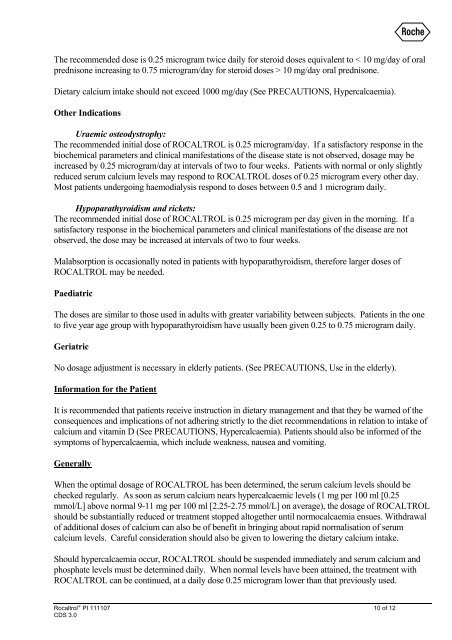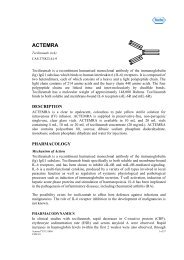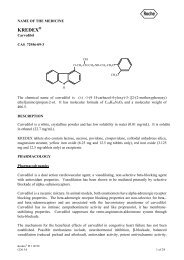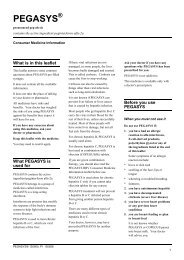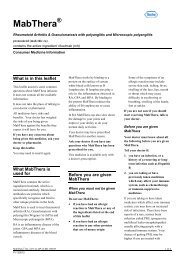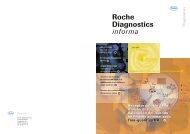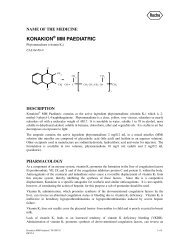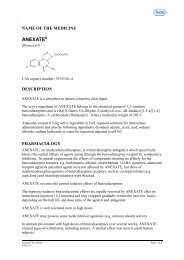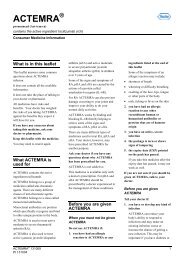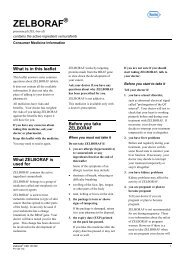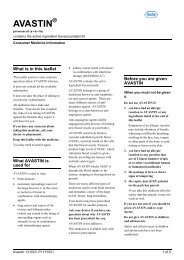Rocaltrol (calcitriol) - Product Information (PI) - Roche Australia
Rocaltrol (calcitriol) - Product Information (PI) - Roche Australia
Rocaltrol (calcitriol) - Product Information (PI) - Roche Australia
Create successful ePaper yourself
Turn your PDF publications into a flip-book with our unique Google optimized e-Paper software.
R<br />
The recommended dose is 0.25 microgram twice daily for steroid doses equivalent to < 10 mg/day of oral<br />
prednisone increasing to 0.75 microgram/day for steroid doses > 10 mg/day oral prednisone.<br />
Dietary calcium intake should not exceed 1000 mg/day (See PRECAUTIONS, Hypercalcaemia).<br />
Other Indications<br />
Uraemic osteodystrophy:<br />
The recommended initial dose of ROCALTROL is 0.25 microgram/day. If a satisfactory response in the<br />
biochemical parameters and clinical manifestations of the disease state is not observed, dosage may be<br />
increased by 0.25 microgram/day at intervals of two to four weeks. Patients with normal or only slightly<br />
reduced serum calcium levels may respond to ROCALTROL doses of 0.25 microgram every other day.<br />
Most patients undergoing haemodialysis respond to doses between 0.5 and 1 microgram daily.<br />
Hypoparathyroidism and rickets:<br />
The recommended initial dose of ROCALTROL is 0.25 microgram per day given in the morning. If a<br />
satisfactory response in the biochemical parameters and clinical manifestations of the disease are not<br />
observed, the dose may be increased at intervals of two to four weeks.<br />
Malabsorption is occasionally noted in patients with hypoparathyroidism, therefore larger doses of<br />
ROCALTROL may be needed.<br />
Paediatric<br />
The doses are similar to those used in adults with greater variability between subjects. Patients in the one<br />
to five year age group with hypoparathyroidism have usually been given 0.25 to 0.75 microgram daily.<br />
Geriatric<br />
No dosage adjustment is necessary in elderly patients. (See PRECAUTIONS, Use in the elderly).<br />
<strong>Information</strong> for the Patient<br />
It is recommended that patients receive instruction in dietary management and that they be warned of the<br />
consequences and implications of not adhering strictly to the diet recommendations in relation to intake of<br />
calcium and vitamin D (See PRECAUTIONS, Hypercalcaemia). Patients should also be informed of the<br />
symptoms of hypercalcaemia, which include weakness, nausea and vomiting.<br />
Generally<br />
When the optimal dosage of ROCALTROL has been determined, the serum calcium levels should be<br />
checked regularly. As soon as serum calcium nears hypercalcaemic levels (1 mg per 100 ml [0.25<br />
mmol/L] above normal 9-11 mg per 100 ml [2.25-2.75 mmol/L] on average), the dosage of ROCALTROL<br />
should be substantially reduced or treatment stopped altogether until normocalcaemia ensues. Withdrawal<br />
of additional doses of calcium can also be of benefit in bringing about rapid normalisation of serum<br />
calcium levels. Careful consideration should also be given to lowering the dietary calcium intake.<br />
Should hypercalcaemia occur, ROCALTROL should be suspended immediately and serum calcium and<br />
phosphate levels must be determined daily. When normal levels have been attained, the treatment with<br />
ROCALTROL can be continued, at a daily dose 0.25 microgram lower than that previously used.<br />
<strong>Rocaltrol</strong> ® <strong>PI</strong> 111107 10 of 12<br />
CDS 3.0


